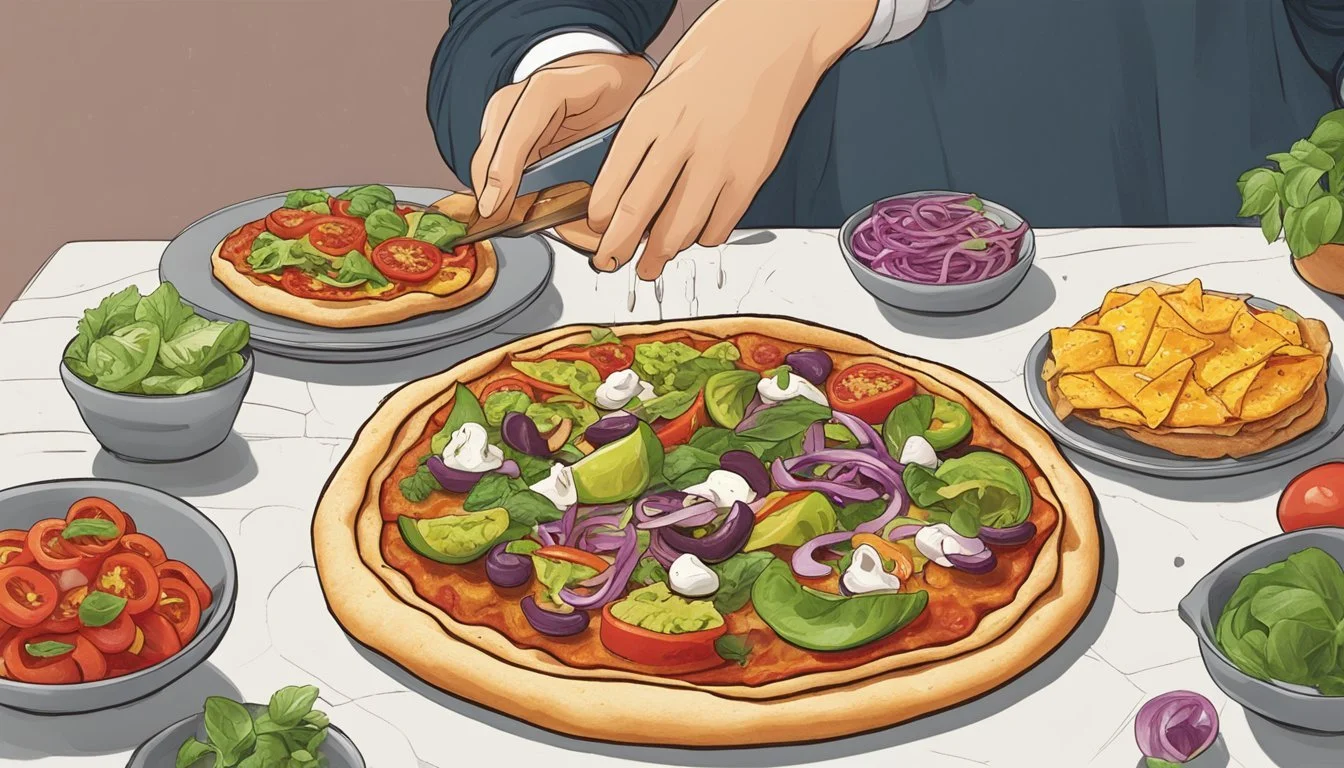Is Pizza Taco Vegan?
Exploring Plant-Based Alternatives in Popular Snack Hybrids
The fusion of Italian and Mexican cuisines has given rise to the taco pizza, (What wine goes well with pizza?) a novel dish that tantalizes the tastebuds with its unique blend of flavors. Yet, the traditional taco pizza – with its customary meat toppings and cheese – does not align with vegan dietary principles. To adhere to vegan standards, every ingredient, from the crust to the toppings, must be plant-based and free from animal products.
Within the realm of vegan cooking, however, innovative solutions have led to the creation of vegan taco pizza options. These pizzas bypass conventional dairy cheese and meat-based toppings in favor of plant-derived alternatives. Ingredients such as vegan sour cream, plant-based cheese, and meat substitutes made from lentils or tofu reinvent the taco pizza in a way that's suitable for those following a vegan lifestyle.
A vegan taco pizza can offer a medley of flavors, including the richness of vegan cheese, the zest of salsa or vegan sour cream for the base, and a host of toppings like avocado, tomatoes (What wine goes well with tomatoes?), lettuce, corn, and kidney beans. Ensuring the pizza dough is vegan, which typically means there are no dairy or eggs involved in its preparation, is vitally important. Cooks often bake the pizza dough until golden and crispy, then garnish it with vegan-friendly toppings to create a satisfying meal that aligns with vegan values.
Examining Veganism
In assessing whether a taco pizza can be considered vegan, one must understand the definition of vegan food and the underlying principles of veganism.
Defining Vegan Food
Vegan food excludes all animal products and by-products, which means it contains no meat, dairy, eggs, or honey. It is important to note that vegan cheese is a key substitute in vegan pizza, providing a dairy-free alternative to traditional cheese. Vegan cheeses are often made from nuts, soy, peas, or root vegetables like cassava.
Core Principles of Veganism
The core principles of veganism involve not only dietary choices but also a lifestyle commitment to avoid animal exploitation. People following a vegan lifestyle abstain from consuming or using anything derived from animals. This extends to clothing, cosmetics, and other products in addition to food. When considering the criteria for veganism and the alternatives available, a taco pizza can be veganized with appropriate ingredient substitutions such as vegan cheese and meat alternatives.
Understanding Pizza
In the quest to explore the diversity of pizza, from its historic roots to the intricacies of crafting the perfect crust and topping combination, one unveils a world of culinary artistry. The journey of pizza from a simple street snack to a global staple reflects its adaptability, including the transformation into vegan varieties that align with modern dietary preferences.
History of Pizza
Pizza's origins can be traced back to ancient civilizations where various forms of flatbreads with toppings were consumed. The pizza that we recognize today has its roots firmly planted in Naples, Italy during the 18th century. Initially, it was the food of the poor, sold in the streets and not considered a kitchen recipe. The modern pizza, characterized by toppings like tomatoes, cheese, and various other ingredients, gained prominence after the tomato's introduction to Europe in the 16th century.
Pizza Dough Essentials
The foundation of any pizza is the dough, a simple mix of flour, water, yeast, and salt. The key to a perfect pizza dough is the formation of gluten, which gives the dough elasticity and the ability to rise. For those with dietary restrictions, gluten-free flours offer an alternative, and vegan pizza dough excludes the use of any animal products, such as dairy or eggs.
Essential Ingredients Description Flour Provides the structure and gluten for the dough. Water Hydrates the flour to create a workable dough. Yeast A vital fungus that causes the dough to rise. Salt Adds flavor and regulates yeast activity. Sugar Often used to help yeast growth and browning of crust. Olive Oil Enriches the dough, adding flavor and moisture.
A pre-made pizza dough can be a time-saver, but many enthusiasts prefer the character and crispiness of a homemade crust. A pizza stone can help achieve a crispy pizza crust by evenly distributing heat.
Selection of Pizza Toppings
Picking the right toppings for pizza involves a balance of flavors and textures. Standard toppings include tomato sauce, mozzarella cheese, and a variety of meats and vegetables. For a vegan pizza recipe, traditional cheese is substituted with vegan cheese options, and meat is replaced with plant-based proteins like tofu or tempeh. To infuse the pizza with more flavor, additional ingredients like oregano, garlic, and a drizzle of olive oil may be used.
The toppings are not only for flavor but also for creating a visually appealing meal:
Vegetable: Avocado, tomatoes, lettuce, corn, and kidney beans.
Herbs and spices: Oregano, red pepper flakes, and garlic.
Vegan proteins: Spicy tofu, lentil walnut meat, or bean paste.
The versatility of pizza toppings (What wine goes well with pizza toppings?) allows for endless combinations, catering to a wide variety of taste preferences and dietary requirements.
The Conception of Taco Pizza
The taco pizza is a culinary innovation that marries the hearty, spiced flavors of traditional tacos with the beloved format of a pizza. This fusion creates a dish that satisfies cravings for both Mexican and Italian cuisines in a single bite.
Fusion of Flavors
Taco pizza epitomizes a harmonious blend of two distinct culinary worlds. Its base is often a traditional pizza crust, which is either pre-baked or freshly prepared to achieve a golden-brown finish. The seasonings play a pivotal role, with taco seasoning, a robust blend of cumin, chili powder, and other spices, bringing the characteristic taco flavor to the forefront. Taco sauce, distinguishable by its tanginess and mild heat, may serve as the pizza's sauce or as a garnish post-baking.
Taco Pizza Variations
The versatility of taco pizza is evident in its variations, which cater to different dietary preferences, including vegan diets. A typical non-vegan taco pizza might feature taco meat, such as seasoned ground beef, layered with cheddar cheese. Vegan versions, conversely, utilize alternatives such as lentil walnut meat or spicy tofu.
Taco toppings are intrinsic to the pizza's identity, with selections including, but not limited to:
Avocado
Tomatoes
Lettuce
Corn
Kidney beans
Vegan cheese (for vegan options)
These toppings, combined with a generous sprinkle of taco seasoning, coalesce to create a taco pizza that is both familiar and novel.
Key Ingredients for a Vegan Taco Pizza
Creating a delectable vegan taco pizza requires carefully selected ingredients that align with plant-based dietary choices while ensuring rich flavors and textures that mimic the classic taco experience.
Vegan Proteins
Spicy Tofu: Typically involves firm tofu seasoned with a blend of spices.
Lentil Walnut Meat: A mix of cooked lentils and finely chopped walnuts, seasoned with taco spices.
Vegan Mince: Plant-based mince can be used as a protein-rich topping.
Beans: Options include refried beans, black beans, pinto beans, and kidney beans for added protein and texture.
Vegan Dairy Substitutes
Vegan Cheese Shreds: Melted on top, they offer a creamy texture similar to traditional cheese.
Vegan Sour Cream: Adds a tangy and creamy component, used as a drizzle or a spread.
Fresh Vegetables and Herbs
Lettuce: Romaine or iceberg, provides a crunchy texture.
Tomatoes: Diced or cherry tomatoes add a juicy, fresh flavor.
Onions: Both red and green onions offer a sharp taste that complements other toppings.
Peppers: Bell peppers or jalapeños for a bit of heat and crunch.
Olives (What wine goes well with olives?) and Spinach: Black olives and spinach can be sprinkled for an extra layer of complexity.
Cilantro and Garlic: Chopped cilantro and minced garlic infuse a bold, aromatic touch to the pizza.
Peppers: Black pepper and red pepper flakes to season and bring some warmth.
Step-By-Step Vegan Taco Pizza Recipe
Crafting a vegan taco pizza combines the savory flavors of traditional tacos with the crispy indulgence of a pizza. The recipe is easy to follow and is perfect for a satisfying dinner or as a standout dish at a party. It balances protein and fiber while keeping a check on sugar and salt, ensuring a nutritious meal that delights the taste buds.
Preparing the Vegan Dough
Firstly, to create the pizza dough, you'll need the following ingredients:
2 cups of all-purpose flour
1 packet (or 2 ¼ teaspoons) of active dry yeast
1 teaspoon of sugar
3/4 teaspoon of salt
1 tablespoon of olive oil
2/3 cup of warm water
In a bowl, mix sugar, warm water, and yeast and allow it to sit until frothy. Combine flour and salt in a separate bowl. Add the yeast mixture and olive oil, then knead until the dough is smooth and elastic, about 5 minutes. Let the dough rest until it doubles in size. Preheat your oven to 385°F (196°C).
Creating the Vegan Taco Toppings
The toppings for your vegan taco pizza can include:
Vegan Taco 'Meat': Brown lentils and walnuts pulsed together, seasoned with onion powder, garlic powder, and traditional taco spices.
Sauce: Vegan sour cream or salsa as the base sauce.
Veggies: Chopped onions, tomatoes, bell peppers, corn, and avocado.
Cheese: Shredded vegan cheese of your choice.
Legumes: Canned kidney beans, rinsed and drained.
Sauté the taco 'meat' in a pan with a touch of olive oil until properly heated and spices are fragrant. Prepare the rest of the toppings by chopping them to the desired size.
Assembling and Baking the Pizza
Once the dough is ready and the oven is preheated:
Spread the dough on a baking sheet lined with oiled parchment paper.
Bake the dough for 10 minutes until it starts to turn golden and crisp.
Remove from the oven and evenly spread your chosen sauce, followed by the vegan taco 'meat', and assorted veggies.
Generously top with vegan cheese and kidney beans.
Place back in the oven and bake for another 5 minutes, or until the vegan cheese has melted and the edges of the crust are slightly browned.
Serve your vegan taco pizza hot. Leftovers can be refrigerated and make an easy, enjoyable meal for the next day.
Customization and Serving Suggestions
A vegan taco pizza offers ample flexibility for customization to accommodate various dietary restrictions and preferences. Thoughtful presentation and pairing elevate the dining experience.
Adapting for Dietary Restrictions
For individuals with gluten intolerance, gluten-free pizza dough is a crucial substitute to ensure they can enjoy the meal without health concerns. Brands such as Bob's Red Mill and King Arthur Flour offer high-quality gluten-free pizza crust mixes that bake up to the perfect combination of crispy and chewy.
Dairy-free needs are naturally met in a vegan taco pizza, but one should carefully check the labels of vegan cheeses for allergens and avoid cross-contact with dairy products during preparation.
Salsa and enchilada sauce can be homemade or store-bought, ensuring they are free from unwanted additives or animal products.
Vegan sour cream is available in stores, or one can blend soaked cashews with lemon juice or lime juice, nutritional yeast, and salt for a homemade variant.
Guacamole is an excellent dairy-free topping, offering a creamy texture that complements the zesty flavors of the other elements.
Presentation and Pairing
Presentation significantly impacts the appeal of vegan taco pizza. Using fresh ingredients for the final touches, like chopped cilantro or a squeeze of lime juice, adds color and vibrancy.
Serve pizza slices with a drizzle of hot sauce for those who appreciate an extra kick.
Pairing the pizza with a side of guacamole and a bowl of salsa encourages dipping and adds layers of flavor.
For a complete meal, consider including a light salad dressed with lime juice to balance the hearty pizza.
When serving, one can offer a variety of taco toppings on the side, such as diced tomatoes, shredded lettuce, black olives, and chopped onions, allowing guests to personalize their slice to their taste.
Storing and Reheating Leftovers
When it comes to leftovers, pizza is one of those meals that can easily be stored and refreshed for later enjoyment. The key is in the approach to refrigeration and reheating to maintain its flavor and texture.
Keeping Pizza Fresh
To keep pizza fresh for later consumption, users should store it properly in the refrigerator. Leftover pizza, whether it's a vegan taco pizza or any other variety, should go into the fridge within two hours of being served to prevent bacteria growth. The pizza should be placed in an airtight container or wrapped tightly with aluminum foil or plastic wrap. If the pizza has vegan cheese toppings or a moist base such as tofu or beans, make sure it's cooled to room temperature before placing it in the fridge to prevent additional moisture from making the crust soggy.
Reviving Pizza for Later Enjoyment
Reheating pizza is a simple process meant to restore its fresh-baked quality. To reheat pizza, an oven or stovetop can do the job effectively:
Oven Reheating:
Preheat the oven to 350 degrees Fahrenheit (175 degrees Celsius).
Place the leftover pizza slices on a baking sheet or directly on the oven rack for a crisper crust.
Heat for about 5-10 minutes, or until the cheese melts and the crust achieves desired crispness.
Stovetop Reheating:
Place a cold, dry skillet on the stovetop over low heat.
Add the cold pizza slices to the skillet, crust side down, and cover with a lid.
Reheat for about 6-8 minutes, checking occasionally for the cheese to melt and the bottom to crisp up without burning.
One should always avoid using a microwave to reheat pizza since it can make the crust chewy and soften any crispy edges. Whether for a vegan pizza with rich sauces or a simple slice with minimal toppings, these reheating methods can help ensure the leftovers are almost as good as when they were first baked.
Nutritional Facts and Benefits
The nutritional profile of a vegan taco pizza is enhanced by its plant-based ingredients, which offer a balance of macronutrients and health benefits. This gastronomic hybrid can cater to vegan, vegetarian, and dairy-free diets while providing options for those who require gluten-free alternatives. The focus on wholesome, plant-derived components ensures an intake of necessary nutrients without animal products.
Caloric and Macronutrient Breakdown
Calories: Vegan taco pizzas may vary in their caloric content depending on the crust and toppings used. A typical slice provides a moderate calorie count that fits into a balanced diet.
Protein: The protein in vegan taco pizzas usually comes from tofu, lentils, or beans, offering a substantial amount per serving without animal products.
Carbohydrates: The crust primarily contributes to the carbohydrate content, which serves as the body’s main source of energy.
Fats: While vegan cheese and avocado provide healthy monounsaturated and polyunsaturated fats, these pizzas are often lower in saturated fat given the absence of dairy.
Nutrient Approximate Amount Per Serving Calories 250-350 kcal* Protein 9-15 g Carbohydrates 35-50 g Fats 7-14 g
* Values are estimated and may vary.
Health Considerations
Consumers seeking a fiber-rich diet benefit from the various plant-based toppings like whole grain crusts, beans, and vegetables, which support digestive health and provide satiety. Vegan taco pizzas are naturally dairy-free, making them suitable for lactose-intolerant individuals. Those looking for gluten-free options can opt for alternative crusts made from ingredients like cauliflower or almond flour. It is important to note that individuals should ensure the balance of their overall diet, as the healthfulness of any pizza choice also depends on portion size and the rest of one's dietary pattern.
Navigating Restaurant Menus
When dining out, vegans must carefully examine restaurant menus to ensure that their pizza taco options are truly vegan, as not all vegetarian options omit animal products.
Popular Pizza Chains
Most pizza chains provide vegetarian options, but the vegan diner must be cautious, as these offerings often include cheese or other dairy products. Taco Bell, for instance, introduced a Veggie Mexican Pizza as an alternative to their traditional Mexican pizza, which includes meat. To adapt this option for vegans, the cheese must be omitted upon request.
Ordering a Vegan Taco Pizza
When ordering a vegan taco pizza from a restaurant:
Verify that the crust and sauces are free from dairy and eggs.
Opt for vegetable toppings and, if available, vegan cheese.
Inquire if the restaurant offers a vegan protein substitute, such as tofu taco meat or lentil walnut meat.
Remember, specificity in your order ensures that your meal aligns with vegan standards.








